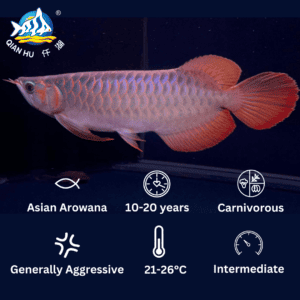Articles
ABOUT AROWANA

Asian Arowana (Scleropages Formosus), also affectionately known as Dragon Fish (龙鱼) in Asia, is native to Southeast Asia. Asian Arowanas inhabit blackwater conditions in rivers and wetland, where the water is soft and acidic.
The Arowana is a geomantic and majestic fish and often regarded as a symbol of luck, wealth and prosperity. Arowana owners believe that if it is treated well, it will protect them from misfortunes and bless them with good fortune and good luck.
pH
The original habitat of Arowana is in the rain forests, where the pH level is around 5.5 to 7 and the water is slightly acidic. Slightly acidic water is one of the critical factors of Arowana’s bright colors, especially Red Arowana. Slightly acidic water is able to encourage the Arowana to naturally develop its body colors without the help of any color enhancing diet.
There is another advantage of a slightly acidic environment. The fish excrement and leftover food will cause a rise in ammonia levels, and ammonia will be converted to nitrite and nitrate, which is harmful for the Arowana. In a slightly acidic environment, ammonia would be converted to non-toxic ammonium, which is safer for the Arowana.
Water Hardness
Water hardness refers to the contents and compositions in the water, like dissolvable calcium, magnesium and iron. These substances are also call “minerals”. Water hardness can be divided into temporary and permanent hardness. Temporary hardness consist of calcium and magnesium bicarbonates. Permanent hardness consists of calcium and magnesium sulfates or chlorides. Therefore, the lesser the hardness substances present, the softer the water will be and vice versa.
During rainy season, the rainwater flows through the immense rainforest area, which creates a slightly acidic and water of lower hardness. Hardness in these regions is mostly at zero. Unfortunately, most of the other regions are hardly able to reach the required standard than the other mountain areas. It will cause great pressure on fish osmo-regulatory function under excessively hard water environment, though it is not obvious in the short-term. Fish’s gills are to breathe and adjust salt contents inside the bodies. When water hardness is lower, fish could discharge unnecessary salt easily and when hardness gets higher, the fish would use more energy to discharge unnecessary salt, thus stressing the gills. Due to such an overload, fish’s gills would damage easily. Therefore, it is necessary to provide an environment of lower hardness.



